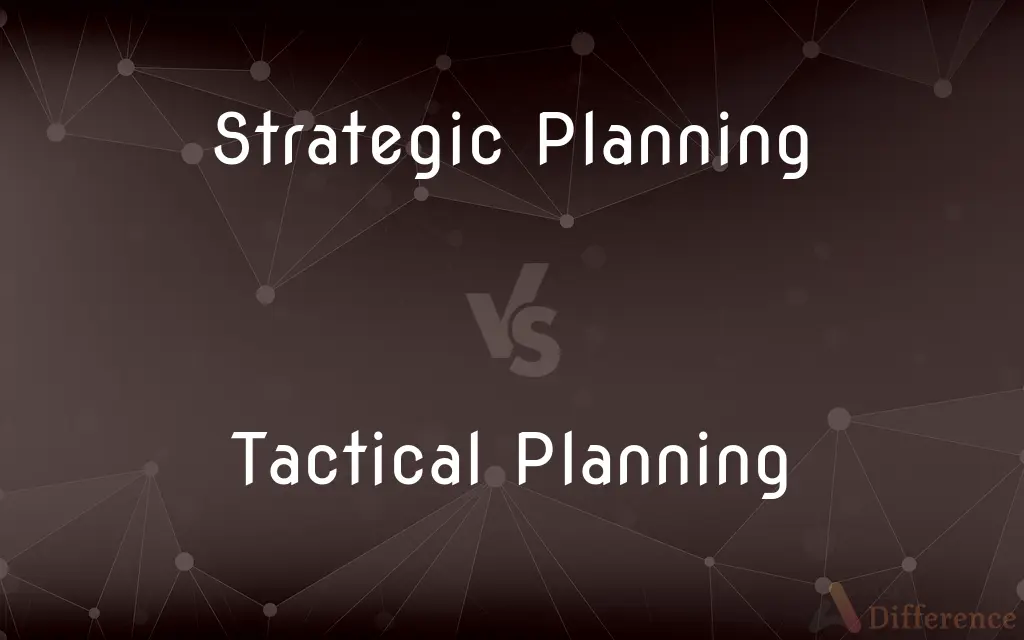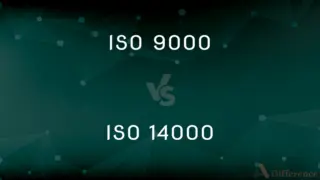Strategic Planning vs. Tactical Planning — What's the Difference?
By Tayyaba Rehman — Published on January 28, 2024
Strategic Planning involves long-term goals and overall vision of an organization, while Tactical Planning focuses on short-term actions and processes to achieve strategic objectives.

Difference Between Strategic Planning and Tactical Planning
Table of Contents
ADVERTISEMENT
Key Differences
Strategic Planning is the process of defining an organization's direction and making decisions on allocating resources to pursue this strategy. It involves setting long-term goals, understanding the organizational environment, and aligning resources for future success. Conversely, Tactical Planning is more immediate, focusing on the short-term actions and processes necessary to achieve parts of the strategic plan.
In Strategic Planning, the focus is on where the organization wants to be in the long-term, often spanning several years. It's about setting priorities, strengthening operations, ensuring employees and stakeholders are working toward common goals, and assessing and adjusting the organization's direction in response to a changing environment. In contrast, Tactical Planning is about how to get there, dealing with the day-to-day operations and making decisions that follow the path set by the strategic plan.
Strategic Planning is typically done by top-level management — the CEOs, directors, or board members — as it requires a broad view of the organization and its environment. It is more about conceptual thinking and less about specific actions. On the other hand, Tactical Planning is often carried out by middle or lower-level management, focusing on specific operations or departmental plans that align with the strategic goals.
The Strategic Plan sets the overall objectives and is less detailed. It's not often changed and serves as a guide for the organization's long-term vision. Tactical Plans, however, are more detailed, flexible, and may change frequently based on the organization's immediate needs and the realities of executing the strategy.
Finally, measurement of success in Strategic Planning is typically in terms of achieving long-term business growth, market share, and sustainability. For Tactical Planning, success is measured through the achievement of specific, short-term operational goals, such as quarterly sales targets, project completion, or operational efficiencies.
ADVERTISEMENT
Comparison Chart
Time Frame
Long-term, spanning years
Short-term, focusing on immediate actions
Focus
Overall organizational direction and long-term goals
Specific actions and processes for achieving parts of the strategic plan
Management Level
Typically top-level management (CEOs, directors)
Often middle or lower-level management
Plan Detail and Flexibility
Less detailed, more about overall objectives; less frequently changed
More detailed, flexible, and may change based on immediate needs
Success Measurement
Achieving long-term growth, market share
Achieving specific short-term operational goals
Compare with Definitions
Strategic Planning
Involves setting priorities and aligning resources.
Through Strategic Planning, we allocated resources efficiently for market expansion.
Tactical Planning
Short-term actions to achieve strategic objectives.
Our Tactical Planning involved quarterly sales targets to meet the strategic goals.
Strategic Planning
Less about specific actions, more about the big picture.
Strategic Planning focused on our overall position in the industry, not day-to-day tasks.
Tactical Planning
More detailed and flexible than strategic plans.
Our Tactical Planning had to be adjusted frequently to adapt to market changes.
Strategic Planning
Measured by long-term business growth and sustainability.
The success of our Strategic Planning was evident in our sustained market leadership.
Tactical Planning
Often carried out by middle or lower-level management.
The department heads were responsible for Tactical Planning within their teams.
Strategic Planning
Long-term goal setting and overall organizational direction.
Strategic Planning helped us define our five-year growth path.
Tactical Planning
Measured by short-term operational goals.
We measured the effectiveness of our Tactical Planning through project completion rates.
Strategic Planning
Carried out by top-level management.
The CEO led the Strategic Planning session to set the company's vision.
Tactical Planning
Focuses on day-to-day operational decisions.
Tactical Planning ensured our daily operations were aligned with our broader strategy.
Common Curiosities
What is Strategic Planning?
It's the process of setting long-term goals and determining the overall direction of an organization.
What is the focus of Tactical Planning?
It focuses on the immediate, short-term actions and operational decisions.
Who is usually responsible for Strategic Planning?
Top-level executives like CEOs and directors.
How often do Tactical Plans change?
They can change frequently based on immediate needs and challenges.
Can Strategic Planning change frequently?
It's generally more static, with infrequent changes, focusing on long-term vision.
What are common Tactical Planning goals?
Achieving quarterly sales targets or completing specific projects on time.
Who typically carries out Tactical Planning?
Middle or lower-level management.
What is Tactical Planning?
It involves developing short-term actions and processes to achieve strategic objectives.
Are Tactical Plans more detailed?
Yes, they provide detailed steps and actions for the short term.
How long do Strategic Plans typically last?
They usually span several years, focusing on long-term goals.
How is success measured in Strategic Planning?
By long-term growth, sustainability, and achieving major milestones.
What indicates success in Tactical Planning?
Meeting short-term operational goals and effectively implementing specific actions.
Can Tactical Planning influence Strategic Planning?
Yes, insights from Tactical Planning can inform and adjust Strategic Plans.
What are examples of Strategic Planning objectives?
Examples include expanding market share, entering new markets, or long-term financial growth.
How detailed are Strategic Plans?
They are less detailed, focusing more on the overall objectives and direction.
Share Your Discovery

Previous Comparison
ISO 9000 vs. ISO 14000
Next Comparison
Will be vs. Would beAuthor Spotlight
Written by
Tayyaba RehmanTayyaba Rehman is a distinguished writer, currently serving as a primary contributor to askdifference.com. As a researcher in semantics and etymology, Tayyaba's passion for the complexity of languages and their distinctions has found a perfect home on the platform. Tayyaba delves into the intricacies of language, distinguishing between commonly confused words and phrases, thereby providing clarity for readers worldwide.












































